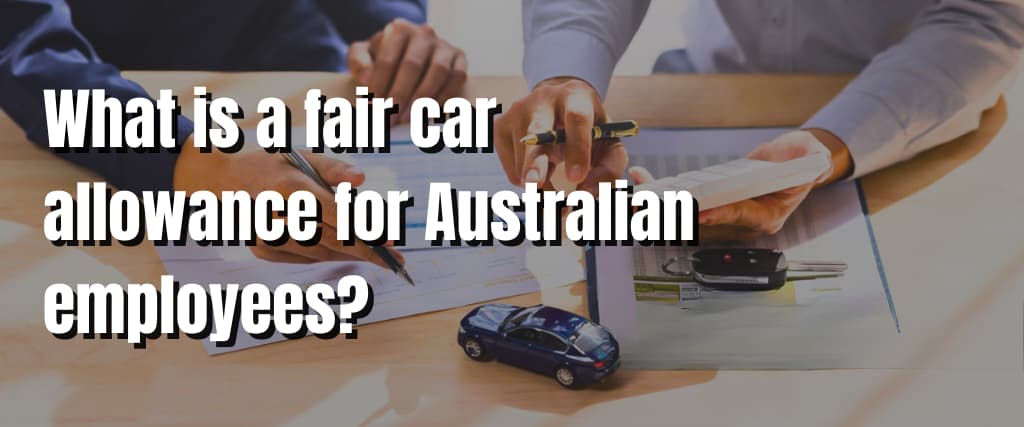In recent years, more companies in Australia have started to introduce a car allowance into the remuneration package they offer their employees.
Typically the scheme covers all work involved in car expenses, including the cost of fuel, repayments of car loans and any maintenance charges associated with its upkeep.
The beauty of this initiative is that it gives employees the opportunity to use their own car for the purposes of work. Therefore reducing any stress or responsibility involved in managing a company car.
If you are thinking of introducing this kind of system into your company, you might be wondering what might constitute a fair car allowance for your employees.
In this article, we will attempt to answer that question for you, as well as provide you with some further information about how car allowances for Australian businesses work.
How Does Car Allowance Work in Australia?
Generally, most companies provide their employees with an allowance that covers any costs incurred when their vehicle is used for the purposes of work.
This allowance is usually paid directly into their employee’s bank accounts along with their salary and is clearly stipulated on their payslips.
Pros and Cons of running a car allowance Scheme in Australia

Like with most things, there are pros and cons involved. For a car allowance scheme in Australia, they include the following:
Pros
1. Employees can drive your own car
One of the obvious differences between running a car allowance system as opposed to a company car scheme is that your employees can use their own vehicle while having the operational costs
involved covered.
This frees them of the responsibility of looking out for someone else’s car.
2. The allowance can be used to purchase a new car
Instead of your company having to splash out on an expensive suite of cars, your employee can use their allowance to purchase a new vehicle.
As the average Aussies spend over $40,000 on a new vehicle, this will have the added benefit of going some way towards reducing their expenses.
3. Employees decide on what vehicle they want to use
Choosing a company car can be quite an expensive and time-consuming decision. So by providing your employees with a car allowance incentive, you free yourself up to concentrate on other work-related projects.
This, in turn, empowers your employees to choose what car they want to drive – whether it be their current or a new vehicle. Which makes them happier and more comfortable on the road.
4. Positive impact on the company
Introducing a car allowance system can garner a number of benefits for your business.
As well as saving you time and money in the process of procuring new company cars, it can also attract new employees and retain existing ones.
Cons
Some of the potential negatives of introducing a car allowance scheme is that it does put plenty of responsibility on your employees.
Not only will they have to find a vehicle that can meet the requirements of their remit, they will also need to keep track of their mileage, save receipts and justify monthly payments whenever they make claims.
As car expenses are eligible for a tax deduction, it is also crucial they accurately keep track of how their car allowance is spent. Otherwise, you could find yourself with accounting issues.
What is a standard car allowance?
In Australia, there is no set or standard amount of car allowance in place.
However, EasiFleet, the automobile finance company believes the average car allowance to fall somewhere between $18,000 and $20,000 a year.
That said, variations will occur between employees as the sum they are entitled to will depend on a number of factors. This includes their position in the company, the length of time they have been in the company and their salary grade.
So what is a Fair Car Allowance in Australia?
If recently published statistics are to be believed, the cost of running a car in Australia can be as much as $17,000 a year when you consider petrol, car insurance, registration and repair.
So a fair car allowance for business purposes should cover some if not all of those expenses.
Using Your Car Allowance to Buy a New Vehicle

Should they want to, employees can also use their car allowance to buy or lease a new vehicle.
If they do this, they will need to decide how much of it they will allocate for any work-related expenses they incur and how much they will set aside to cover payments for a new car or an existing one.
This will depend on the total amount of car allowance they receive and what finance option they secure.
Here is a quick overview of some of the main types you can get:
Consumer Loan
The most common of all finance options when purchasing a new vehicle is a car loan.
With this type of loan, the borrower takes ownership of the vehicle from the start outright, while making monthly repayments. The car acts as security for the loan and will probably be repossessed if
your employee is unable to make regular payments.
The good thing about this finance option is they are not able to borrow more than what the car is valued at. They will also have to meet certain other criteria that will ascertain how much they can borrow for the purchase of the car.
Chattel Mortgage
Employees that get an allowance for car-related work expenses may wish to consider applying for a chattel mortgage.
Similar to a secured car loan, it is mainly applied to assets that are bought for use by businesses.
By taking up this type of loan, they might be able to write off some business expenses as tax deductible and also pay less in depreciation, interest and GST.
Car Lease
In this situation, the financial lender owns the vehicle and leases it to your employee for a specific period of time.
On the completion of the lease, the employee might decide to pay the remaining value of it in order to own it outright, or just give it back to the lender.
Novated Lease
Also known as a salary sacrifice vehicle scheme, a novated lease, is an agreement between the employee, the lease provider and your company.
In this scenario, your company agrees to pay the repayments for the car loan on behalf of the employee from their pre-tax salary.
The benefit of this to your employee is that it will reduce their income and therefore the amount of income tax they will need to pay. As they won’t have to pay GST either, they are essentially leasing the car instead of buying it.
An additional benefit is that this lease also covers ownership and operational costs like registration, fuel, maintenance, insurance and roadside assistance.
On completion of the lease, employees can either trade the vehicle in or keep it.
Is Car Allowance Taxable?
Essentially a car allowance is not classed as a tax-free income. Indeed it is viewed in the same manner as any other income and therefore taxed accordingly.
That said, this income may be offset partially or wholly through the claiming of tax deductions that are car-related. This works in the same way as claiming regular car expenses for work-related activity.
A few examples of when you might put in a claim for tax deductions that are car-related may include:
– Picking up or delivering products or items
– Visiting the office or worksite of a client.
– Travelling to multiple locations a day as required by your job remit
– Attending conferences, exhibitions or meetings that take place offsite from your office
– Travelling from one employer to another (if you have two jobs)
When calculating tax deductions for work-related car expenses there are two methods you can use:
Cents per km: The current rate as determined by the ATO is 72 cents per km. As it is capped at 5000 km – or $3600 in terms of value – this method is more popular among companies whose employees don’t use their vehicles all that often.
Logbook: This method is ideally suited to employees who use their car frequently for work and get a car allowance of over $15k. You will need to use the ATO’s free myDeductions tool or maintain a physical logbook to keep a track of your expenses.
It is worth noting that should the car be provided to your employee through a novated lease they will not be able to claim these expenses on their individual tax returns. This is because the deduction would have already been applied with the salary sacrifice scheme.
Mileage Reimbursement In Australia

As an alternative to getting a set figure each month for a car allowance, your company could choose to reimburse their employees with a mileage rate of their own.
This could apply to a car that is owned by the employee or the company.
As an employer, you will not have to use the same rate as determined by the ATO. However, if the employee gets a higher rate than the recommended 72 cents, they will need to declare any excess in their tax return as income.
Final Thought
These days, a car allowance is becoming a standard benefit for employees. Especially those that are dependent upon it for their work duties.
While some companies might still prefer to stick to the company car for branding purposes, an increasing number are realising the benefits of a car allowance system.
When implemented properly it can create a real win-win scenario for both the employee and your company, which is what every business should strive to achieve.


